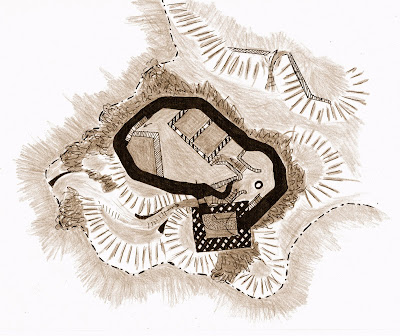From the Royal Commission on Ancient and Historical Monuments of Scotland
Occupying a rocky peninsula in a commanding position overlooking Loch Way on the Hebridean island of Greft, Carscaway Castle (Gaelic Dun Cearcabhagh) comprises a curtain wall following the contours of the summit of the peninsula to form an irregular enclosure with a later tower at the SE superadded over the curtain and projecting therefrom. On analogy with similar castles in the region (Dunvegan etc.), the curtain is likely to date from the 13th or early 14th century and the tower from the late 14th-early 15th.
In the NW quadrant of the curtain, steps ascend to the wall head but no details of the wall head arrangements survive. The entrance is in the SW quadrant following a natural defile altered with the addition of masonry and steps cut into the rock to form a corridor curving round in to upper (W) part of the courtyard. The tower is two storeys over a vaulted undercroft, the entrance in the east face at 2nd floor level accessed by a stair against the inside of the curtain of later date. Again, no details of the wall head survive. Inside the courtyard are traces of later buildings against the inside of the curtain of two phases. The earlier comprises a building to the W apparently contemporaneous with additions to the entrance corridor to the upper courtyard. Against the NE wall is a building – possibly the principal accommodation of the castle after the abandonment as such of the tower – with vestigial detail suggesting a mid 17th century date.
History - The seat of the MacAllans of Greft, there are no contemporary references to the castle until Dean Monro reported in 1549 “ane greite strengthe perteinyng to Alane Alansoune Vick Alane”. The castle was fired and its garrison hanged by Lieutenant Nash of the frigate Hyena in the aftermath of the royalist Glencairn Rising against Cromwell in 1654. It was never reoccupied, the MacAllans taking up residence at Greft House after their rehabilitation at the Restoration. Upon the 25th chief’s bankruptcy in 1850, his estates were bought by Viscount Ogleby. In 1910, Lord Ogleby contemplated a full restoration of the castle (similar to Eilean Donan and Duart) but finding the costs prohibitive contented himself with a detailed survey (see illustration above) and sympathetic stabilisation works to consolidate the ruin. Following acquisition of the island by the Storas Greabhaid (“Greft Resources”) crofting trust in 2008, improved public access is planned in conjunction with Historic Scotland.
Subscribe to:
Post Comments (Atom)


No comments:
Post a Comment